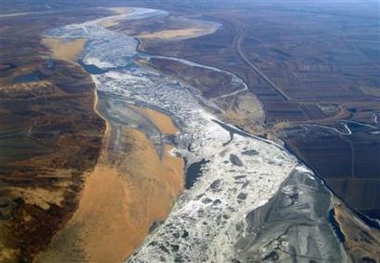|
Cities to examine chemical slick impact
By Li Fangchao (China Daily)
Updated: 2005-12-13 06:13
After more than three weeks of suffering due to a chemical slick, the levels
of toxicity in the stretch of the Songhua River in Harbin, capital of Northeast
China's Heilongjiang Province, have returned to normal.

A stretch of
potentially lethal polluted river water headed towards one of China's
biggest cities on Thursday after an explosion at a petrochemical plant,
November 24 2005. [newsphoto] |
Local officials have now pledged to focus on restoring day-to-day life, and
examine the long-term impact of the accident.
"It is now time to switch our attention from emergency prevention to
appraisal work of the impact of the slick on the ecology of the Songhua River,
and also speed up our attempts to resume normal business and social order," said
Zhang Zuoji, governor of Heilongjiang Province.
The toxic slick was caused by a chemical plant blast on November 13 in Jilin
City, Jilin Province, which led to more than 100 tons of chemicals, mainly
benzene and nitrobenzene, entering the adjacent Songhua River.
The toxic slick forced Harbin, with an urban population of 3.8 million and
Dalianhe, where 26,000 out of the 36,000 residents rely on river water as their
drinking water source, to cut their water supply for several days.
By 8 am on Monday, the concentration of benzene and nitrobenzene at all water
checking stations within the precinct of Harbin remained under the national
standard, which means the toxic slick has passed through, sources with the
Heilongjiang Provincial Environment Protection Bureau said.
And yesterday, Dalianhe, which cut its water inlet from the river on November
30, resumed water supply both for industrial and civilian use, although the
local government advised residents not to drink it before receiving the go-ahead
from the local health bureau.
By noontime yesterday, the front of the contaminated water arrived at Suibin
County, Jiamusi, the second major city in Heilongjiang to be affected.
Residents' life has not been affected as they mainly rely on underground
water sources.
No poisonous pollutants were detected in the drinking water in Jiamusi, which
has an overall population of more than two million, according to Jiamusi
Environment Protection Bureau.
There are still some 200 kilometres before the slick reaches Tongjiang, where
the Songhua River joins the Heilong River, the border river between China and
Russia.
|